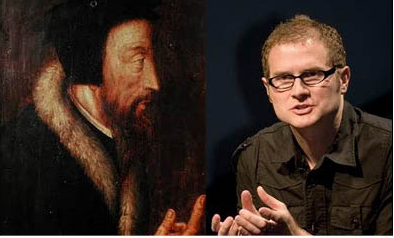This Reformed Life: Finding Joy in the Contemporary American Religious Climate (part 1)
I grew up as a pastor’s kid. I’ve remained a committed Christian despite the fact. And having spent the better part of the last fifteen years looking for the perfect church I’ve finally committed to the reformed expression, jumping in with both feet. In this four part series I hope to sketch out some of the highlights of this long arduous process, anticipating a full article in the forthcoming e-journal Figtree Theological Quarterly, a free 1 year subscription available by signing up here.
Having grown up Conservative Baptist and worshiping in non-denominational churches I’ve had a fairly nonchalant attitude toward the creed and confessions as a guiding principle of Sunday service. This is not my fault; formal statements can’t claim the same allegiance as scripture, says Spurgeon and the creeds hinder the creative, dynamic energy of worship, says Barth. But two things happened to change my mind about the importance of a confessional form of worship: kids.
Most non-denominational churches offer a myriad of social programs and group activities with a religious component somewhere in the mix. I’ve always had fun at these things but after a while the social component takes the place of the theological component and spiritual growth usually seems to wane. Worship service often struggled for quality content. After a while experimentation takes the place of edification. As a church-goer I constantly felt like I was being experimented on: ‘What programs do you like?’ ‘What message do you need to hear?’ ‘What’s going to make you adhere to our ministry?’ What seemed like an endless freedom for the substitution of the creeds was turning into a Sartre-like nightmare of boundless freedom.
Now while I was going through all this I was reading staple theology from all the reformed quarters, most notably the Puritans. (save for article)
The two theoretical strongholds keeping me from being totally Reformed were the creeds and infant baptism. These two items make the church seem like a crusty old institutional wife instead of the young, bright, sexy co-ed image that the emerging church likes to project. When taken to task on infant-baptism as a sign of Church ‘institution’ (as opposed to the vibrant, organic, pilgrim church) Calvin simply shrugged (Milner). Richard Baxter thought ‘what am I saying if I don’t baptize children?’ (Packer). So the giants have it. I’m cool with it.
Next time we pick up with the kids, confessionalism, and why becoming Reformed is so chill.




This looks like an interesting series. Will be reading future posts.
Agreed. I’ll be tuning in as well.
<>
Sola Scriptura. Don’t give in that easy.
“So the giants have it. I’m cool with it.”
Sola Scriptura. Don’t give in that easy.
Hi Joel, I’m glad to see you’re still a Christian. I’ve remained
active in the writing/music area.
Robert Pearson
No, this painting does not tell all about the aristt, but it tells a lot about the self-projection of Jonathan Jones. Really, as a painter, you can’t buy into the self-contradictory stuff he writes. Ce9zanne has changed a benign view he feared might be picturesque into an almost apocalyptic spectacle . It takes a lot of personal drama to mistake blue skies reflecting on a perfectly still lake, with nature being flooded by sun, for a storm. And, as a matter of fact, Cezanne did not sneer at the view. He sneered at the empty and transient beauty viewers would normally take out of it. So, he did it differently, in his own way, the secret of which Mr Jones does not seem to want to really understand.